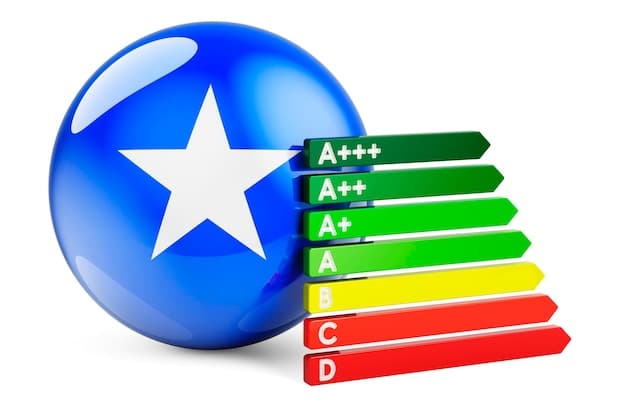Maximize Your Savings: Energy-Efficient Home Upgrade Tax Credits

The new tax credits for energy-efficient home upgrades offer substantial financial incentives to homeowners, allowing them to claim up to $3,200 in benefits for qualified improvements. These credits aim to promote energy conservation and reduce carbon emissions by making energy-efficient upgrades more accessible and affordable.
Discover how to claim up to $3,200 in new tax credits for energy-efficient home upgrades, making your home greener and saving you money.
Understanding the Energy-Efficient Home Improvement Tax Credits
The energy-efficient home improvement tax credits are a set of incentives designed to encourage homeowners to invest in upgrades that reduce energy consumption. These credits are part of a broader effort to promote sustainability and reduce the nation’s carbon footprint, playing a vital role in making homes more environmentally friendly while also lowering energy costs for homeowners.
These tax credits not only benefit the environment but also provide significant financial relief to homeowners who choose to make energy-efficient improvements. Understanding the specifics of these credits, including eligibility requirements and the types of upgrades that qualify, is crucial for maximizing the potential savings.

Key Components of the Energy-Efficient Home Improvement Tax Credits
The tax credits are divided into two main categories: the Energy Efficiency Home Improvement Credit and the Residential Clean Energy Credit. Each has different criteria and covers different types of improvements, offering a comprehensive approach to incentivizing energy efficiency.
- Energy Efficiency Home Improvement Credit: This credit covers improvements like insulation, energy-efficient windows, doors, and certain types of heating and cooling equipment. It aims to reduce the energy consumption of the home directly.
- Residential Clean Energy Credit: This credit focuses on renewable energy sources such as solar, wind, and geothermal. It encourages homeowners to invest in systems that generate clean energy on-site.
- Eligibility Requirements: Specific requirements apply to each type of credit, including product standards, installation guidelines, and the overall impact on energy efficiency.
Knowing the specifics of what qualifies under each credit is crucial for homeowners looking to take advantage of these incentives.
In summary, the energy-efficient home improvement tax credits offer a powerful combination of environmental and financial benefits, incentivizing homeowners to make upgrades that reduce energy consumption and promote sustainability.
What Upgrades Qualify for the Tax Credits?
Knowing which upgrades qualify for tax credits is essential for homeowners aiming to maximize their savings. Not all improvements are eligible, so understanding the specific criteria for qualification is crucial.
These tax credits are designed to incentivize a wide range of energy-efficient upgrades, from insulation to renewable energy systems. By identifying the eligible improvements, homeowners can strategically plan their projects to take full advantage of the available incentives.
Specific Upgrades Covered by the Credits
Several types of home improvements qualify for the energy-efficient tax credits, each with its own set of requirements and limitations. Understanding these specifics can help homeowners make informed decisions about which upgrades to pursue.
- Insulation: Upgrading insulation in attics, walls, and basements can significantly reduce energy loss, making it a key area for tax credits.
- Energy-Efficient Windows and Doors: Replacing old, drafty windows and doors with energy-efficient models can improve a home’s thermal performance.
- Heating and Cooling Equipment: Installing high-efficiency furnaces, air conditioners, and heat pumps can lower energy bills and qualify for tax credits.
Each of these upgrades must meet specific energy efficiency standards to qualify for the credits, ensuring that the improvements result in meaningful energy savings.

Selecting the right upgrades not only helps reduce energy consumption but also ensures that homeowners can take full advantage of the available tax incentives.
Overall, the key to maximizing tax credit savings lies in understanding which upgrades qualify and ensuring they meet the specific requirements set by the IRS. By carefully selecting and implementing these improvements, homeowners can create a more energy-efficient and financially rewarding home.
How to Claim Up to $3,200 in Benefits
Claiming up to $3,200 in energy-efficient home upgrade tax credits involves a detailed process. Understanding each step is essential to successfully obtain the benefits.
To ensure you receive the tax credits, it’s crucial to follow the necessary procedures and accurately document your expenses and improvements. This section will guide you through the steps required to make your claim.
Step-by-Step Guide to Claiming the Tax Credits
Claiming the energy-efficient home upgrade tax credits requires careful attention to detail. From gathering documentation to filling out the necessary tax forms, each step plays a critical role in the process.
- Determine Eligibility: Ensure that the upgrades you’ve made qualify for the tax credits by checking the specific requirements and standards.
- Gather Documentation: Collect all receipts, invoices, and certifications related to the energy-efficient improvements.
- Fill Out the Necessary Tax Forms: Complete IRS Form 5695 for the Energy Efficiency Home Improvement Credit and any other applicable forms.
Accurate and thorough documentation is key to a successful claim.
Navigating the claims process can seem daunting, but with the right preparation and knowledge, homeowners can successfully claim the tax credits they are entitled to, maximizing their savings.
In conclusion, claiming up to $3,200 in energy-efficient home upgrade tax credits requires a clear understanding of the eligibility criteria, detailed documentation, and careful completion of the necessary tax forms. By following these steps, homeowners can confidently secure the benefits of their energy-efficient investments.
Understanding the Tax Forms and Paperwork Needed
Navigating the tax forms and paperwork needed to claim energy-efficient home upgrade tax credits might seem complicated, but it’s a critical part of receiving your benefits.
Knowing which forms to use and what information to provide can make the process much smoother. This section will help you understand the essential paperwork needed to successfully claim your tax credits.
Key Tax Forms for Claiming the Credits
The IRS has specific forms designed for claiming energy-efficient home improvement tax credits. Understanding these forms is crucial for accurately reporting your expenses and claiming the appropriate credits.
- IRS Form 5695 (Residential Energy Credits): This is the primary form used to claim both the Energy Efficiency Home Improvement Credit and the Residential Clean Energy Credit.
- Instructions for Form 5695: These instructions provide detailed guidance on how to complete the form, including eligibility requirements and calculation methods.
- Additional Documentation: Keep copies of receipts, invoices, and manufacturer certifications for all qualifying purchases and installations.
Accurate and complete documentation ensures a smoother filing process and reduces the risk of delays or denials.
Successfully navigating the tax forms and paperwork is essential for homeowners looking to claim energy-efficient home upgrade tax credits, requiring careful attention to detail and a thorough understanding of IRS requirements.
In summary, understanding the key tax forms and maintaining accurate documentation are crucial steps in claiming energy-efficient home upgrade tax credits. With the right preparation and attention to detail, homeowners can confidently navigate the process and receive the financial benefits they deserve.
Maximize Your Savings: Tips and Strategies
To maximize savings with energy-efficient home upgrade tax credits, strategic planning and informed decision-making are key.
By understanding the nuances of the tax credits and employing effective strategies, homeowners can significantly increase the financial benefits they receive, optimizing their investments in energy efficiency.
Effective Strategies to Maximize Tax Credit Savings
Several strategies can help homeowners maximize their tax credit savings. These involve careful planning, selecting the right upgrades, and properly documenting expenses.
- Plan Ahead: Develop a comprehensive plan for energy-efficient upgrades, prioritizing those that offer the greatest tax credit benefits.
- Choose Qualified Products: Ensure that all purchased products meet the specific energy efficiency standards required for the tax credits.
- Document Everything: Keep detailed records of all expenses, including receipts, invoices, and manufacturer certifications.
These strategies, combined with a thorough understanding of the tax credit guidelines, can significantly enhance the savings potential.
Incorporating these tips and strategies into your planning process can significantly enhance your tax credit savings, making your energy-efficient home upgrades even more financially rewarding.
In conclusion, maximizing savings with energy-efficient home upgrade tax credits requires strategic planning, careful selection of qualified products, and meticulous documentation. By employing these strategies, homeowners can optimize their financial returns and enjoy the long-term benefits of a more energy-efficient home.
Common Mistakes to Avoid When Claiming Tax Credits
Claiming energy-efficient home upgrade tax credits can be straightforward if you avoid common mistakes. Awareness and careful preparation are key to a successful claim.
By knowing what to avoid, you can minimize the risk of errors and ensure that you receive the maximum benefits you are entitled to, saving both time and money in the long run.
Frequent Errors and How to Prevent Them
Several common mistakes can derail your attempt to claim energy-efficient home upgrade tax credits. Knowing these pitfalls can help you avoid them and ensure a smoother process.
- Ineligible Upgrades: Ensure that the upgrades you are claiming actually qualify for the tax credits by checking the specific requirements.
- Missing Documentation: Keep all receipts, invoices, and certifications for every purchase and installation.
- Incorrect Forms: Use the correct IRS forms and fill them out accurately, following the instructions carefully.
Avoiding these common errors can save time, reduce stress, and ensure that you receive the full tax credits you are entitled to.
By avoiding these common mistakes, homeowners can ensure a smoother and more successful claim process, maximizing their financial benefits from energy-efficient home upgrades.
In summary, avoiding common mistakes when claiming energy-efficient home upgrade tax credits requires careful attention to detail, a thorough understanding of eligibility requirements, and accurate documentation. By being proactive and informed, homeowners can confidently navigate the claims process and enjoy the financial rewards of their energy-efficient investments.
| Key Point | Brief Description |
|---|---|
| 💰 Claim Amount | Homeowners can claim up to $3,200 in tax credits for eligible upgrades. |
| ✅ Qualifying Upgrades | Includes insulation, energy-efficient windows, doors, and HVAC systems. |
| 📝 Tax Form | Use IRS Form 5695 to claim the Residential Energy Credits. |
| 💡 Planning Ahead | Strategy is planning your upgrades and keeping detailed records. |
Frequently Asked Questions (FAQ)
▼
The maximum amount you can claim is $3,200 for energy-efficient home improvements. This limit applies to the collective value of all qualifying upgrades made during the tax year.
▼
To claim the energy-efficient home improvement tax credits, you will need to fill out IRS Form 5695, titled “Residential Energy Credits.” This form is specifically designed for these types of credits.
▼
Yes, there are specific energy efficiency standards that your upgrades must meet to qualify. These standards are set by the IRS and often reference Energy Star criteria for certain products.
▼
When claiming the credits, you should provide receipts, invoices, and manufacturer certifications for all qualifying purchases and installations. This documentation helps verify that the upgrades meet the required standards.
▼
No, these tax credits are generally only available to homeowners who own the property where the energy-efficient upgrades are made. Renters are typically not eligible to claim these credits.
Conclusion
In conclusion, the new tax credits for energy-efficient home upgrades present a significant opportunity for homeowners to save money while making their homes more sustainable. By understanding the eligibility requirements, following the claiming process, and avoiding common mistakes, you can maximize your benefits and contribute to a greener future. Taking advantage of these incentives not only helps your wallet but also supports a more environmentally conscious lifestyle.





